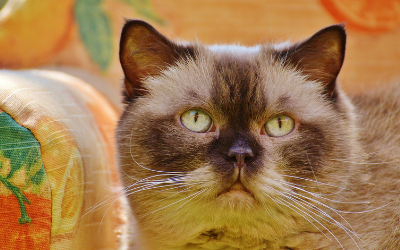
Cat Day is coming up on October 29th!
What better way to celebrate cats than to debunk some of the common myths about them!
- Cats always land on their feet. While it is true that cats will often land on their feet, this isn’t always the case. Each spring and summer when the temperatures rise, so too does the incidence of “high-rise syndrome.” This term was coined in the 1980s when an animal treatment center in New York City treated over 100 cats that had fallen out of high-rise buildings during a five-month period. Cats’ reflexes often allow them to turn right-side-up as they fall, depending on the height they fall from. Cats falling from low heights don’t necessarily land on their feet because they don’t have time to right themselves. Even if a cat does land on her feet, she may sustain severe injuries to her back, legs, pelvis, or head. Prevent falls by securing window screens and keep your cat off the balcony.
- Cats only purr when they are happy. You may be surprised, but cats also purr when in pain. Purring may actually increase in a cat experiencing pain. If your cat is purring while showing signs of pain (e.g., changes in eating/drinking, litter box, and grooming habits; and reluctance to be picked up or touched), seek veterinary care for your furry friend.
- Cats need milk. Cats do not need milk (unless, of course, you are thinking of newborn kittens who do, indeed, need milk – their mother’s or a specially formulated kitten milk replacement – but not cow’s milk). If your cat has a well-balanced diet designed for your cat’s specific life stage, she will get all the nutrients she needs. Milk can cause stomach upset as most adult cats are lactose-intolerant (meaning they can’t digest lactose in milk very well).
- Cats and dogs never get along. Dogs and cats can often get along – it may just take some time. If a new dog is being introduced into the home, take steps to make the introductions slowly. Keep the dog on his leash during initial introductions. Allow one pet to roam free while the other is confined. This allows each pet to become familiar with the other one’s presence. Some dogs have a strong prey instinct and love to chase, pin, or pick up animals they see as fair game. This can include cats. Likewise, some cats may growl, swat at, or run and hide from dogs. This needs to be taken into account when considering mixing a dog and cat in the household. Be aware, careful, and patient and ask for help if you need it!
- Cats are indifferent or aloof. Cats are just as loving as dogs. Cats can develop deep bonds with their family members and rely on their humans for companionship. Some cats develop separation anxiety if they are left alone for a long time.
- Cats can’t be trained. Does your cat use a litter box? If so, your cat has been trained, and you can train her to do other “tricks” as well. Cats can be trained to “come,” walk on a leash, scratch on a post (and conversely NOT to scratch the furniture!), get her nails trimmed, shake a paw, and even to sit, roll over, and shake a paw!
- Cats are low-maintenance. No pet is really “low-maintenance” and cats are no exception! Cats need fresh food and water every day, as well as litter box maintenance. They need love, affection, and attention. Playing with your cat should be a daily activity, not a special occasion!
- Rubbing butter on your cat’s paws will help her find her way home. When moving from one home to another, a popular suggestion is to rub butter on your cat’s paws. The idea behind this is that licking to remove the butter will also remove the scent of the previous home, as well as provide the cat the opportunity to survey the new home to become familiar with the scents, sounds, and sights. Rubbing butter on your cat’s paws, however, will only make her paws (and your floors!) greasy and stress her out! To help your cat adjust to her new home, keep her indoors for at least two weeks. Accompany her the first few times she goes out and don’t let her out at night. Make sure she is microchipped – if she does get lost, there’s a higher chance of being reunited.
- Cats are nocturnal. While it may seem like your cat is nocturnal, performing crazy antics in the middle of the night, cats are crepuscular, meaning they are most active during twilight – periods of dawn and dusk. This instinctive behavior stems from hunting when opportunities to capture prey are better and there is just enough light for them to see. If your cat is active at night you can train her to sleep at night by increasing her daytime activity level, feeding her largest meal right before bedtime, and ignoring her nighttime antics. This may involve confining her to an area of the house where you can’t hear her pleas to play.
- Cats hate water. Most cats do not like water, possibly because their coats don’t dry very quickly, leaving them cold and a soggy mess, but one only needs to check the internet to see evidence that some cats do, indeed, love water!